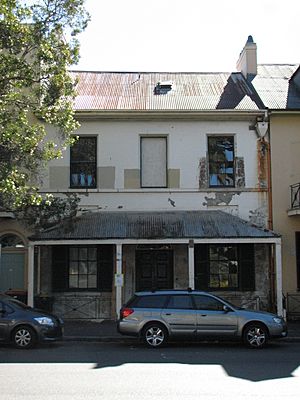Dawesleigh facts for kids
Quick facts for kids Dawesleigh |
|
|---|---|

Dawesleigh, 37 Lower Fort Street, Dawes Point, NSW, being renovated in 2019.
|
|
| Location | 37 Lower Fort Street, Dawes Point, City of Sydney, New South Wales, Australia |
| Built | 1830–1840 |
| Architectural style(s) | Colonial Georgian |
| Official name: Dawesleigh; Royal College of Radiologists; 37 Lower Fort Street | |
| Type | State heritage (built) |
| Designated | 2 April 1999 |
| Reference no. | 522 |
| Category | Residence |
| Lua error in Module:Location_map at line 420: attempt to index field 'wikibase' (a nil value). | |
Dawesleigh is a historic house located at 37 Lower Fort Street in Dawes Point, a suburb of Sydney, Australia. It was built between 1830 and 1840. This building is also known as the Royal College of Radiologists and 37 Lower Fort Street. It is a privately owned property. Dawesleigh was added to the New South Wales State Heritage Register on April 2, 1999. This means it is officially recognized as an important historical place.
Contents
What is Dawesleigh?
Dawesleigh is a large, old house built in the Colonial Georgian style. It is part of a row of similar houses. These homes offer amazing views of the harbour. Many people believe Dawesleigh was one of the first houses built on Fort Street. It was likely built before 1830. The land was once part of the estate of Robert Campbell. He was a well-known businessman in Sydney at that time.
Who Built Dawesleigh?
Two young men, Thomas Dyer Edwards and Matthew Dysart Hunter, built Dawesleigh. They were both in their early twenties. They built it to be both their home and their business office. Thomas had been an orphan in England. He worked briefly on a farm in Jamaica. Later, he traveled to China.
In 1833, big changes happened. Slavery was ended in the British Empire. Also, a major trading company lost its special rights in China. Around this time, Edwards and Hunter arrived in Sydney from China. They started their own trading company. This company soon managed most of the trade with China. They built Dawesleigh as their main office and home. Their company, called Edwards & Hunter, worked closely with another big trading company. Throughout the 1830s, Edwards & Hunter grew very successful. New business partners joined the company. Many of them lived in nearby houses on Lower Fort Street. By the early 1840s, Edwards had retired. He moved back to England with his family. Hunter also returned to Scotland.
How Dawesleigh Changed Over Time
In 1903, a serious illness spread. This led the government to take over many houses. They took control of homes in Dawes Point, Millers Point, and The Rocks. The government had plans for new docks and warehouses. They also planned a new bridge across the harbour. Some houses were torn down. New apartments were built for workers. The houses that remained were rented out. Dawesleigh was rented to John Haroldson. By 1910, Alfred S. Carpenter was living there.
After World War I, Dawesleigh became a hostel. A hostel is a place where people can rent rooms. Several women ran the hostel over the years. These included Ethel Wilson, Rose Shackel, and Florence Ann Dee. France Barwyck ran it from 1957 to 1975. After that, the house was greatly changed. It became the office for the Royal Australian and New Zealand College of Radiologists. This is a group of doctors who study X-rays and scans. The College moved out in the early 1990s. Then, people who lived there without permission moved in. The house was almost falling apart. The NSW Government decided to sell it. The current owners bought Dawesleigh in 2009. They began to fix it up and restore it.
A Look Inside Dawesleigh
Dawesleigh is located in the historic Millers Point area. It sits on a high spot. This gives it great views of the harbour from both the front and back. It is a two-story house with a basement and an attic. It was likely built around 1840. The front of the house has three sections. The main entrance has a central door with eight panels. Above the door is a beautiful, curved window called a fanlight. This window is supported by decorative columns on each side. Inside, the house still has most of its original wooden features and details.
Condition of the House
As of 1998, the house was in good condition. This old Georgian style house still looks much like it did in the 1800s. Inside, many of its original details are still there. The inside of the house has been updated.
Why is Dawesleigh Important?
Dawesleigh is important for several reasons. It shows how big houses and townhouses were built. These homes were often on ridges overlooking the harbour. It also helps make the street beautiful and historically rich. The house is a great example of its architectural style.
Dawesleigh was listed on the New South Wales State Heritage Register in 1999. This means it met certain requirements.
It shows the history of New South Wales. Dawesleigh is important because it shows how Sydney developed. It is physical proof of the big houses built overlooking the harbour. It also adds to the look of a street that is important for its history and buildings.
It shows great design and skill in New South Wales. The house adds to the look of a street that is important for its history and buildings. It is also a wonderful example of its architectural style.

